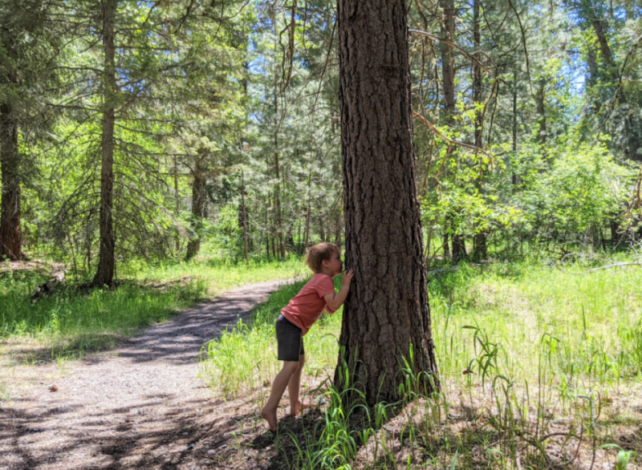Exploring Nature with Your Senses: Smell
- Blog Exploring Nature with Your Senses: Smell
While wandering through nature, we take in our surroundings using our senses. We smell flowers, touch tree bark, listen to bird calls, see details (like an ant trail on a tree), and even taste some of the natural objects we come across (think berries or edible flowers). And, while investigating nature in this way comes naturally to most children, sometimes we forget to allow children the time and space they need to do it.
We are sharing five different ways to explore each of the five senses with children. So get outside as a family, slow down, and explore nature with your senses together!

Photo credit: Katie Fox
Exploring Nature by Smell
Our sense of smell is an incredibly important part of our body and plays a role in how we perceive the world around us. Not only is the sense of smell linked to memories and emotions, but our noses can smell about 10,000 different smells in the area the size of a postage stamp.
In other words, you and your children take in a lot of different smells every single second of every single day. But how often do you sit and really consider what you are smelling, especially while you are exploring the great outdoors with your children? Oh did we mention that the smells of nature are linked to lower physiological stress? It totally is!
Here are five ways you can slow down and use your noses in nature together:
- Smell a tree. Walk up to any tree and see if you can detect a smell. If you live near ponderosa pine trees, make sure to give their bark a sniff. They smell like vanilla or butterscotch and it is truly delightful. All trees have some sort of smell, it just takes some time to walk up and smell them.
- Complete a nature-smelling scavenger hunt. You can use literally any nature scavenger hunt, but instead of seeing them in nature, take a moment to smell them. You can take this even further and try to smell every item on your list or by taking a moment to stop and describe the way each item smells. Maybe even rank them from best to worst smelling.
- Put your nose to the ground. No, you won’t really be sniffing out clues but instead investigating how different ground cover smells. How does grass smell compared to dirt? What about a ground covered in wet, Autumn leaves? Snow, sand, moss, a rocky riverbank, a muddy puddle, and so many more walkable surfaces all have distinct smells and should be explored to your heart’s content. Or, you know, until your children are thoroughly filthy. We all know the muddy puddles and wet leaves will be the favorite exploratory option on this smell-hunt.
- Stop and smell the roses and literally any other flower you see. All flowers smell different and spending time sniffing them is an easy way to pass the time in the Spring and Summer months. There are even a few Fall and Winter wildflowers, though they are harder to find. If wildflowers are not easily found, try visiting a nursery or flower shop and smelling the flowers there.
- Play a guessing game by scent. This is an easy way to use your nose to explore nature and it can even be done in your own backyard! All you do is help your children gather a few nature items, like pinecones, grass, leaves, sticks, rocks, dirt, flowers, fragrant herbs, etc., and then guess which item is which based on the way it smells. You and your children can simply close your eyes while you sniff each item or you can use a blindfold. This is an easy game to set up, but surprisingly it is not as easy to guess each item correctly.
Want to learn more about exploring nature with your senses? Check out our other posts on using your senses of hearing, taste, touch, and sight!
ABOUT OUTGROWN
OutGrown is a 501(c)(3) nonprofit that works to create a world where everyone can enjoy the physical and mental benefits of spending time outside. We are focused on creating opportunities and removing barriers to access so families with babies and young children can take their first steps outside. We believe all families have the right to connect with nature, benefit from spending time outdoors and be inspired to a lifelong love of nature. Since its grassroots inception in 2013, OutGrown is a growing community of 280,000 families and over 300 volunteer Branch Ambassadors. More information on all of our programs can be found at WeAreOutGrown.org
EDITORS NOTE:
We hope you enjoyed reading this article from OutGrown. We’re working hard to provide our community with content and resources that inform, inspire, and entertain you.
But content is not free. It’s built on the hard work and dedication of writers, editors, and volunteers. We make an investment in developing premium content to make it easier for families with young children to connect with nature and each other. We do not ask this lightly, but if you can, please make a contribution and help us extend our reach.
Related Content





Comments